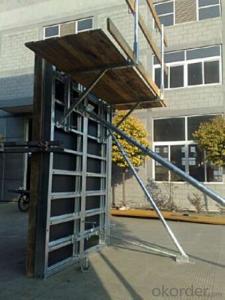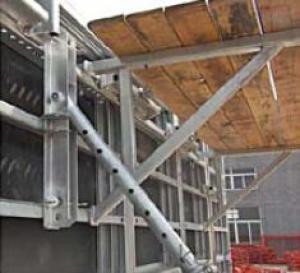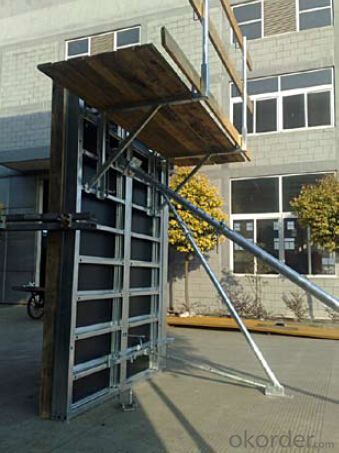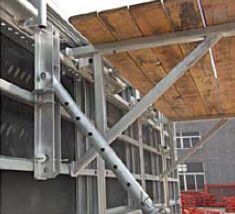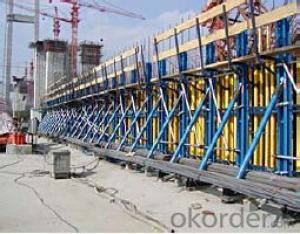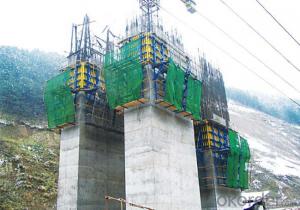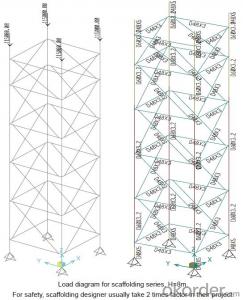Steel-frame working platformfor Formwork and Scaffolding system
- Loading Port:
- Tianjin
- Payment Terms:
- TT OR LC
- Min Order Qty:
- 50 m²
- Supply Capability:
- 1000 m²/month
OKorder Service Pledge
OKorder Financial Service
You Might Also Like
Steel-frame Formwork SF-140
Characteristics:
◆ Few parts for fast forming.
◆ Max. Concrete pressure: 80KN/m2.
◆ Hot-dip galvanized steel frame.
◆ The thickness of plywood is 18mm & the panel is 14cm.
◆ Compatibility with Hunnebeck Manto system due to similar edge profile.
System Details & Application:
◆ Neat joint and fast assembling with aligning panel clamp.
◆ Flexible panel arrangement and height extension.
◆ The selection of panels.
◆ Kinds of panel connectors.
◆ Corner clamp application.
◆ Length adjustment application.
◆ Height adjustment & aligning strut.
◆ Walkway bracket & platform.
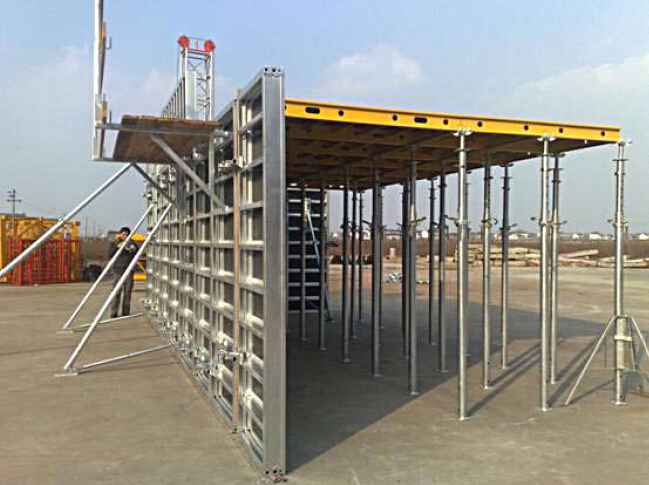
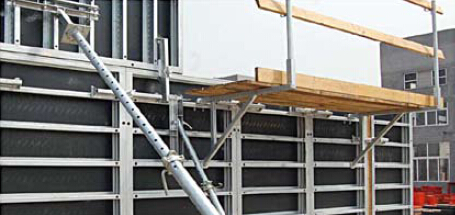
- Q: Can steel formwork be used for both small-scale and large-scale construction projects?
- Steel formwork is suitable for both small-scale and large-scale construction projects. Its versatility allows it to be customized to meet the specific requirements of any construction project. With excellent durability and strength, steel formwork can withstand the pressures exerted during large-scale projects. It is easily assembled and disassembled, making it efficient for use on construction sites of any size. Moreover, steel formwork provides a smooth and consistent finish, guaranteeing high-quality results regardless of the project's scale. Therefore, whether it is a small residential building or a large commercial complex, steel formwork can effectively achieve the desired construction objectives.
- Q: Can steel formwork be used for underground parking structures?
- Yes, steel formwork can be used for underground parking structures. Steel formwork provides a strong and durable solution for constructing the walls, columns, and slabs of underground parking structures. It offers several advantages such as high strength, flexibility, and the ability to withstand the pressure exerted by the soil and water in underground conditions. Steel formwork also allows for faster construction compared to traditional formwork systems, as it can be easily assembled and disassembled, and it requires minimal maintenance. Additionally, steel formwork is reusable, making it a cost-effective choice for underground parking structures. Overall, steel formwork is a suitable and efficient option for constructing underground parking structures.
- Q: Are there any environmental considerations when using steel formwork?
- Yes, there are several environmental considerations when using steel formwork. Firstly, steel production is energy-intensive and contributes to greenhouse gas emissions. However, steel formwork can be reused multiple times, reducing the need for new materials and minimizing waste generation. Additionally, proper disposal and recycling of steel formwork at the end of its lifespan is important to reduce environmental impact. Overall, while steel formwork has certain environmental drawbacks, its reusability and recyclability make it a more sustainable option compared to other formwork materials.
- Q: How does steel formwork contribute to the overall strength and stability of a structure?
- Steel formwork is a crucial component in the construction industry that greatly contributes to the overall strength and stability of a structure. It plays a vital role in ensuring the integrity and durability of the building by providing a robust and reliable support system during the concrete pouring process. Firstly, steel formwork offers exceptional strength and rigidity, making it capable of withstanding the immense weight and pressure exerted by wet concrete. Its sturdy construction ensures that the formwork does not deform or collapse under these heavy loads, preventing any potential damage or compromise to the structure's stability. Moreover, steel formwork provides an accurate and precise framework for the concrete to be poured into. The dimensional stability of steel ensures that the formwork maintains its shape and dimensions throughout the construction process. This accuracy is crucial in achieving a structurally sound and level structure, as any misalignment or irregularity in the formwork can lead to uneven distribution of concrete and weaken the overall strength of the building. Furthermore, steel formwork offers excellent resistance to moisture and corrosion. This resistance ensures that the formwork remains intact and structurally sound, even in environments with high humidity or exposure to water. By preventing rust and deterioration, steel formwork maintains its strength and stability over time, contributing to the long-term durability of the structure. Another significant advantage of steel formwork is its reusability. Unlike traditional wooden formwork, steel formwork can be reused multiple times without compromising its structural integrity. This reusability not only reduces construction costs but also minimizes waste and environmental impact. The ability to reuse steel formwork ensures that the subsequent concrete structures maintain consistent strength and stability, without any compromise in quality. In conclusion, steel formwork is an essential element in the construction industry that significantly contributes to the overall strength and stability of a structure. Its exceptional strength, dimensional accuracy, resistance to moisture and corrosion, and reusability make it an ideal formwork choice for ensuring the integrity and durability of concrete structures. By providing a robust and reliable support system, steel formwork plays a crucial role in constructing safe and long-lasting buildings.
- Q: How does steel formwork handle different concrete reinforcement types?
- Steel formwork is a versatile and durable option for handling different types of concrete reinforcement. It is commonly used in construction projects to create temporary molds or structures to hold concrete in place during the pouring and curing process. One of the advantages of steel formwork is its ability to handle different concrete reinforcement types. Whether it is traditional reinforcement such as steel bars or modern reinforcement techniques like fiber-reinforced polymers (FRP), steel formwork can accommodate them all. Steel formwork is designed to be strong and rigid, which allows it to support the weight and pressure exerted by different types of reinforcement materials. Whether it is the weight of steel bars or the tensile strength of FRP, steel formwork can withstand these forces without deforming or collapsing. Additionally, steel formwork is highly adaptable and can be easily adjusted or modified to accommodate different reinforcement types. It can be cut or welded to create openings or recesses for steel bars or other reinforcement materials to pass through. This flexibility ensures that steel formwork can be customized to suit the specific needs of each construction project. Furthermore, steel formwork offers a smooth and even surface finish, which is crucial for ensuring proper adhesion between the concrete and the reinforcement materials. This ensures that the reinforcement is securely embedded within the concrete structure, providing the necessary structural integrity and strength. In conclusion, steel formwork is a reliable and effective solution for handling different concrete reinforcement types. Its strength, adaptability, and ability to provide a smooth surface finish make it an ideal choice for construction projects that require diverse reinforcement materials.
- Q: Can steel formwork be used for school construction projects?
- Yes, steel formwork can be used for school construction projects. Steel formwork is a durable and versatile construction material that can withstand the heavy loads and pressures encountered in school buildings. It provides a strong and stable framework for concrete pouring, ensuring the structural integrity of the construction. Additionally, steel formwork is reusable, which makes it a cost-effective choice for school construction projects. Its adaptability allows for the creation of various shapes and sizes, catering to the unique architectural designs often seen in school buildings. Furthermore, steel formwork offers faster construction times compared to traditional timber formwork, allowing for quicker completion of school projects. Overall, steel formwork is a suitable and reliable choice for school construction projects.
- Q: How does steel formwork affect the overall cost-effectiveness of a construction project?
- Steel formwork can greatly enhance the overall cost-effectiveness of a construction project in several ways. Firstly, steel formwork is highly durable and reusable, which means it can withstand multiple uses without any significant wear and tear. This reduces the need for frequent replacements, resulting in cost savings in terms of material expenses. Moreover, steel formwork offers excellent dimensional stability, ensuring accurate and precise construction. This eliminates the need for excessive adjustments and rework, saving both time and money. Additionally, the smooth surface finish provided by steel formwork reduces the need for additional plastering or finishing, further reducing construction costs. Furthermore, steel formwork is known for its high strength and load-bearing capacity. This allows for larger spans and fewer support beams, reducing the amount of material required, and consequently reducing costs. The structural integrity and stability of steel formwork also contribute to a reduction in the number of labor hours required for installation and dismantling, resulting in labor cost savings. In terms of time efficiency, steel formwork offers faster assembly and disassembly compared to traditional formwork systems. This can significantly reduce construction durations, leading to cost savings associated with labor, equipment rental, and overhead expenses. Additionally, steel formwork is highly adaptable and versatile, making it suitable for a wide range of construction projects. Its flexibility allows for customization and adjustments as per project requirements, reducing the need for multiple formwork systems for different construction elements. Overall, the utilization of steel formwork in a construction project can contribute to significant cost savings, thanks to its durability, reusability, dimensional accuracy, reduced finishing requirements, material efficiency, time efficiency, and adaptability. It not only minimizes material and labor costs but also enhances productivity, ultimately resulting in improved cost-effectiveness.
- Q: Can steel formwork be used for both indoor and outdoor construction projects?
- Yes, steel formwork can be used for both indoor and outdoor construction projects. Steel is a highly durable and robust material that can withstand various weather conditions, making it suitable for outdoor projects. It provides excellent strength and stability, allowing it to support the weight of concrete and other construction materials. Additionally, steel formwork is reusable, which makes it a cost-effective choice for both indoor and outdoor projects. Its versatility and resilience make it a popular choice among construction professionals for various applications.
- Q: What are the different types of formwork joints used in steel formwork?
- In steel formwork, there are various types of formwork joints that are commonly used. These joints are designed to ensure the proper alignment, stability, and strength of the formwork system. Some of the different types of formwork joints used in steel formwork include: 1. Butt Joint: This is the most common type of joint used in steel formwork. In this joint, two formwork panels are aligned end-to-end, with the edges in direct contact with each other. The panels are then secured using bolts or clamps to ensure a tight fit. 2. Lap Joint: In a lap joint, one formwork panel overlaps the other, creating a connection between the two panels. This joint provides additional strength and stability to the formwork system. The overlapping portion is usually secured using bolts or clamps. 3. Corner Joint: As the name suggests, a corner joint is used to connect two formwork panels at a corner. This joint is typically formed by cutting and welding the panels at a 90-degree angle. The welded joint ensures a strong and secure connection between the panels. 4. T-Joint: A T-joint is formed when one formwork panel intersects another panel at a right angle, creating the shape of the letter "T". This joint is commonly used in complex formwork systems where multiple panels need to be interconnected. 5. Hinged Joint: A hinged joint is used when there is a requirement for a flexible connection between two formwork panels. This joint allows for movement and adjustment of the panels, which can be useful in situations where the formwork needs to accommodate irregular shapes or angles. 6. Slip Joint: A slip joint is used to create a temporary and adjustable connection between two formwork panels. This joint allows for easy removal and repositioning of the panels during the construction process. It is often used when the formwork needs to be adjusted for different pour heights or angles. These are just a few examples of the different types of formwork joints used in steel formwork. The choice of joint depends on the specific requirements of the construction project, including factors such as load-bearing capacity, ease of assembly and disassembly, and overall stability of the formwork system.
- Q: How does steel formwork affect the overall maintenance requirements of the structure?
- Steel formwork can significantly impact the maintenance requirements of a structure in a positive way. Its durability and strength make it resistant to wear and tear, reducing the need for frequent repairs or replacements. Additionally, steel formwork provides a smooth and even finish, minimizing the potential for cracks or other structural issues that could arise over time. This results in reduced maintenance costs and efforts, ensuring a longer lifespan for the structure.
Send your message to us
Steel-frame working platformfor Formwork and Scaffolding system
- Loading Port:
- Tianjin
- Payment Terms:
- TT OR LC
- Min Order Qty:
- 50 m²
- Supply Capability:
- 1000 m²/month
OKorder Service Pledge
OKorder Financial Service
Similar products
Hot products
Hot Searches
Related keywords
